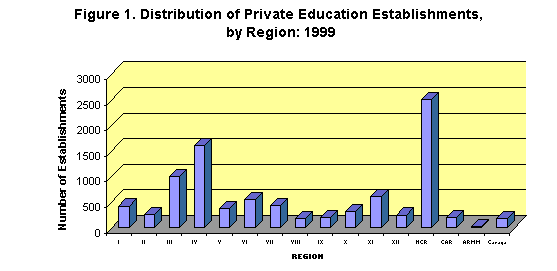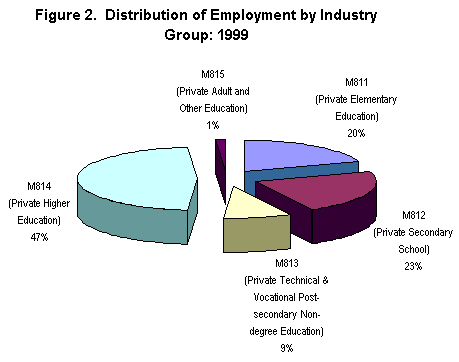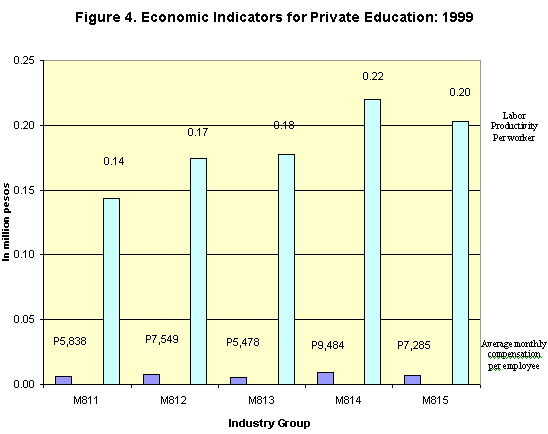-
A total of 9,111 establishments providing private education services nationwide were reported in the 2000 Census of Philippine Business and Industry (CPBI), around 75.8 percent (6,911 establishments) had an average total employment (ATE) of less than 20. The remaining 2,200 or 24.2 percent had an average total employment of 20 and over. See Table 1 for the Summary statistics for all private education establishments.
-
Majority of these establishments (46.7 percent) were private elementary schools (PSIC M811); followed by private secondary education establishments (M812) with 18.5 percent; private technical and vocational post-secondary schools offering non-degree education (M813), 15.4 percent; private higher education establishments (M814), 12.3 percent; and private adult and other education establishments (M815) with only 7.0 percent of the total count.
-
Private education establishments were concentrated in the National Capital Region (NCR) where 2,512 establishments or 27.6 percent were located. The Autonomous Region in Muslim Mindanao (ARMM) accounted for the least number with only 27. establishments. Figure 1 shows the distribution of private education establishments by region.

-
The private education sector provided employment to some 250,296 workers, 96.9 percent of which were paid employees. Most of these employees (47.3 percent) were hired by private higher education establishments (M814) while private adult and other education establishments (M815) accounted for only 1.4 percent of the total employment. Figure 2 displays the distribution of employment by industry group.

-
Regional distribution shows that NCR employed some 83,234 or 33.2 percent of total workforce. Southern Tagalog (Region IV) had the second biggest employment with 35,731 while ARMM had the lowest among the regions, with 705 workers.
-
Compensation paid amounted to more than 23.2 billion in 1999. This translates to an average monthly compensation of P7,975 per paid employee.
-
On the average, employees of private higher education (M814) establishments were the highest paid with P9,484 per month. The least paid were those in the private technical and vocational post-secondary non-degree education (M813) establishments with only P5,478 per month.
-
Total revenue earned by the sector in 1999 amounted to 47.8 billion. Private higher education (M814) contributed the largest share of revenue of P26.08 billion or 54.6 percent. Private adult and other education (M815) with. only P0.71 billion or 1.5 percent of the total revenue. Figure 3 illustrates the distribution of revenue and costs by industry group.

-
Excluding compensation paid to employees, total costs spent to operate and maintain private education establishments reached P14.76 billion.
-
Bulk of total revenue and cost was generated and incurred by NCR, with 48.4 percent and 48.0 percent respectively.
Revenue per peso cost was valued at P 1.85
-
Revenue per worker, a measure of labor productivity, was estimated at P0.191 million. Private higher education (M814) establishments exhibited a higher labor productivity of P0.22 million. On the other hand, private elementary education (M811) had the lowest productivity of P0.14 million. Figure 4 shows labor productivity per worker and average monthly compensation per employee for the private education sector. See also Tables R1 to R3 for other economic indicators.

Source: National Statistics Office
Manila, Philippines
Release Date :
Reference Number :
2004-107
